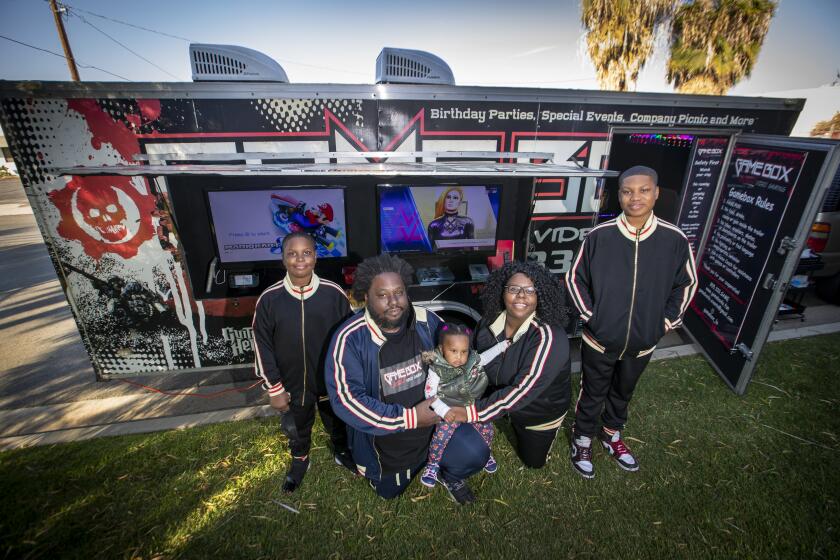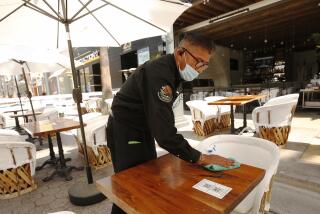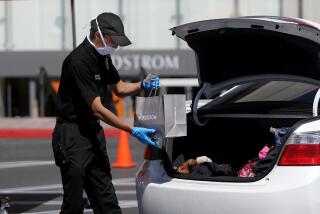COVID-19 slammed small businesses — but a surprising number are thriving
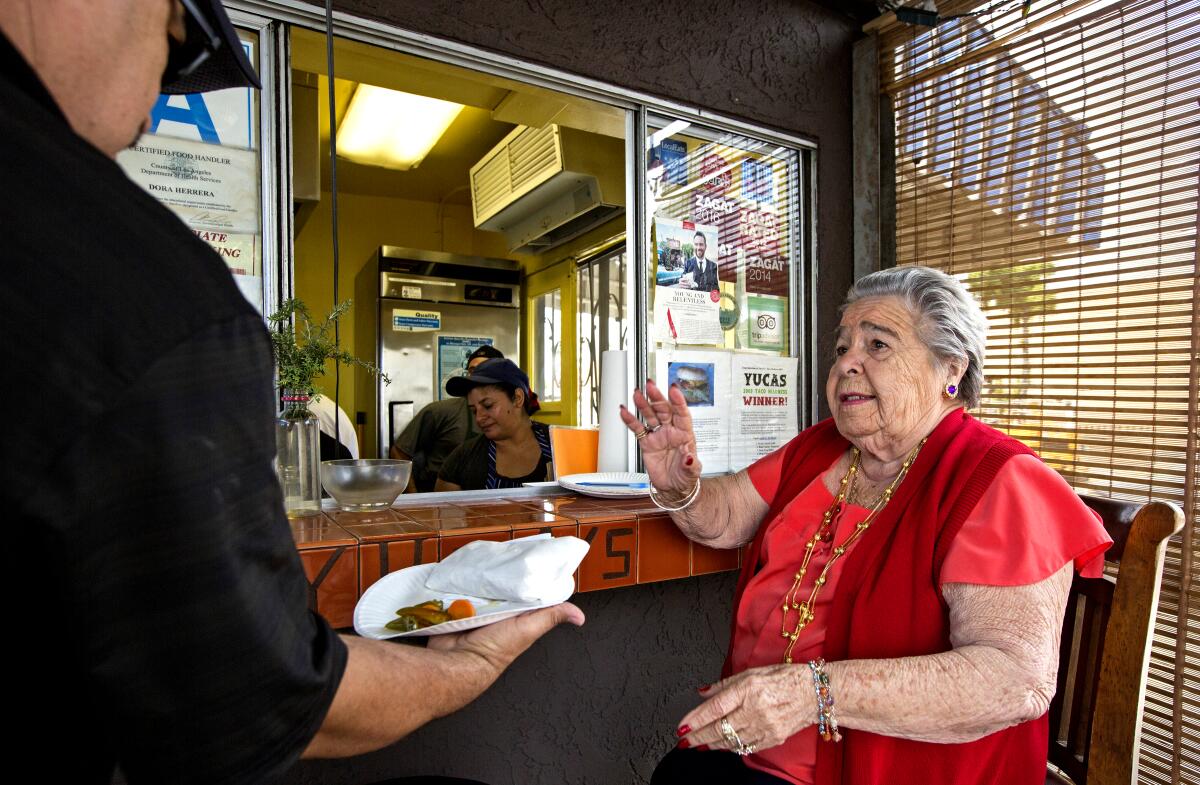
- Share via
Things looked grim for Dora Herrera last spring. Revenues at her family’s 44-year-old restaurant business, Yuca’s, had plummeted within a few short weeks as COVID-19 kept customers away from its two popular taco shacks, in Los Angeles and Pasadena.
The drop was precipitous. By late April things reached “a point where we were like, if we don’t get more customers or cash, we’re going to close on Monday,” she recalls.
A federal loan arrived in early May, providing enough money for eight weeks of payroll. In the months that followed, additional loans and grants — and Yuca’s fast-footed adaptations to pandemic restrictions — kept the business alive, though the stress remained.
“We always said we’ll figure out how to pay that loan back later,” Herrera said. “It was, ‘Just stay alive. Just stay alive.’”
America’s small businesses play a central role in the nation’s economy and culture. According to a recent fact sheet from the U.S. Small Business Administration, 31.7 million small businesses in 2017 employed 60.6 million people — nearly half of American employees. Small businesses created 1.6 million additional jobs in 2019. They generated 32% of the nation’s exports in 2018.
Business leaders, policymakers and regular folks have sounded increasing alarm about how mom-and-pop businesses will weather the COVID-19 pandemic. But a surprising number of these outfits, including Yuca’s, seem to be hanging on. COVID-19 apparently is packing a punch, but not a knockout — so far. Rather than wiping everyone out, the pandemic is creating winners and losers.
Definitively quantifying the pandemic’s effect is difficult: There’s no centralized way to track small-business failures in the US. Many researchers rely on survey data, from the Census Bureau and elsewhere, with findings that often aren’t clear.
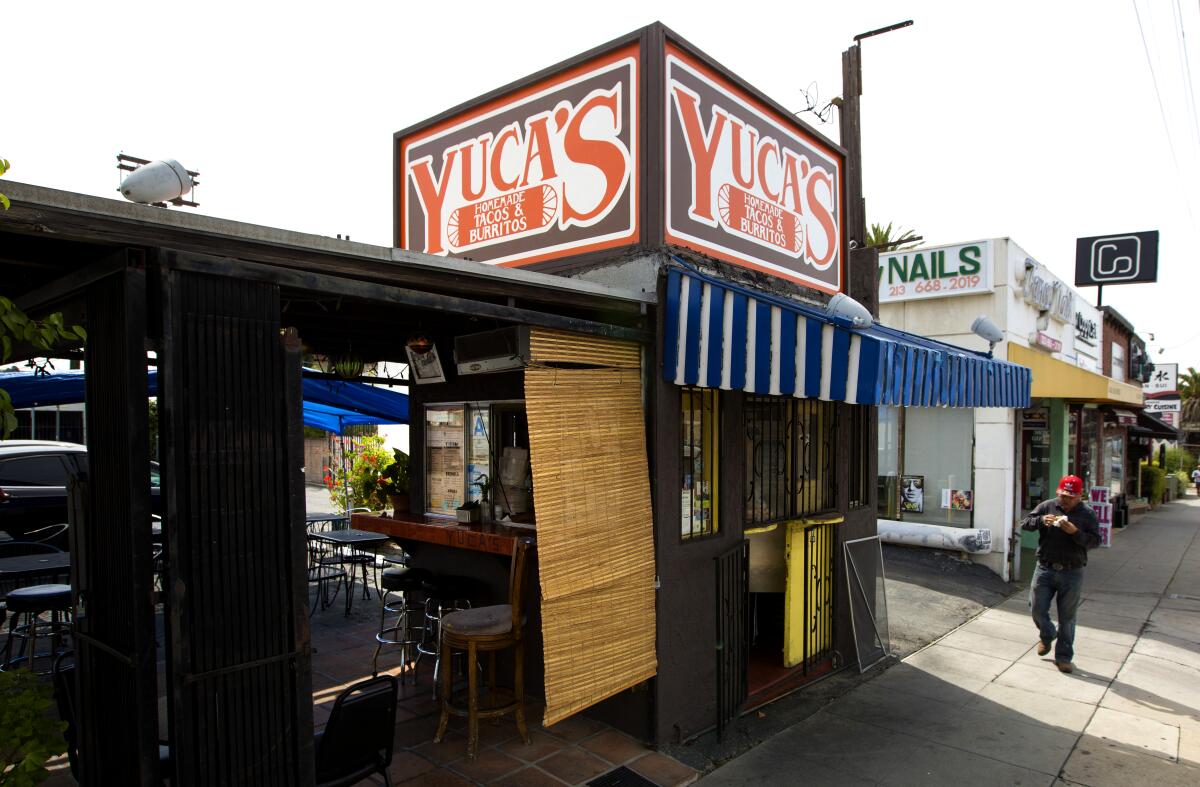
Michael Powe, director of research for Main Street America, a Chicago nonprofit that works with local partners to revitalize downtown districts throughout the U.S., conducted a survey of nearly 6,000 small businesses in late March and early April. It showed that almost 80% had closed for some period of time in the first weeks of the pandemic, and that entrepreneurs needed help.
The data suggested that around 7.5 million American small businesses would close by the fall of 2020.
That didn’t happen. Survey data that Powe collected in August showed that less than 10% of the businesses he expected would shut down reported having done so. Did things look rosy because owners of failed ventures weren’t inclined to answer surveys? Were stressed-out entrepreneurs leaning on savings, credit card debt and retirement accounts to avoid officially closing up shop?
Figuring out what might be going on is vital, economists say. Because small business is so important, its stumbles stoke the economic woes that Americans face today. Unemployment reached record levels during the pandemic, and without federal government assistance, many expect a devastating drop in tax revenues in the spring — which would probably result in cuts to public services and programs.
A recent analysis by Moody’s Analytics calculated that states might lose $434 billion from their budgets by 2022 because of COVID-related income and sales tax shortfalls.
Why small is a big deal
Beyond dollars and cents, small businesses cement communities. Local places like coffee shops become routine gathering places, said sociologists Martha Crowley of North Carolina State University and Kevin Stainback of Purdue University, who have collaborated on research into the effect of small businesses on towns.
And local business creates a virtuous circle, plowing money and resources back into the community. A big-box store might shell out payments to accountants in Arkansas and lawyers in New York, but a small local shop is likely to patronize service providers in the neighborhood. Local businesspeople have a stake in community welfare.
Herrera says that Yuca’s has always been “very community-oriented” — a place where neighbors would walk by and give her mother (who started the business, along with Herrera’s father) “a hundred hugs a day.”
When COVID hit, Herrera tried to do her bit to support local business, ordering food from other nearby restaurants and posting about it on social media. She’s doing a lot of networking and has worked with community groups to help feed essential workers. “A rising tide raises all boats. We’re trying to help ourselves and help others too,” she said.
The struggles of small businesses are a multifaceted reason for worry. “Widespread business closure has social costs that extend beyond the obvious losses to owners and workers,” said Charles Tolbert, a sociologist at Baylor University in Waco, Texas.
Losing small businesses rips away at a neighborhood’s fabric, Crowley and Stainback, the researchers, said in an interview. Research shows that it took decades for big-box stores to wreak havoc on American towns, Stainback said, but the pandemic may have a similar effect in a matter of months.
A 2019 analysis by the researchers in the Annual Review of Sociology looked at studies of what happened in American communities after big-box retailers — particularly, Walmart, which is more widely studied than other companies — swooped in and wiped out smaller competitors. In many places, wages and jobs fell.
One study documented “greater increases (or smaller decreases) in family-poverty rates” after Walmarts came to town during the late 1980s and much of the 1990s.
Another suggested that drops in presidential voting rates, nonprofit activity and church adherence may have also been linked to the demise of small businesses. When big-box stores wiped out mom-and-pop grocers, people began buying less healthy foods, including fewer fruits and vegetables, and obesity rates climbed.
Crime rates increased too — perhaps as a function of neighbors losing walkable main streets, and larger swaths of shoppers flocking instead to vast and often sparsely patrolled parking lots, the research found.
Today, small-business owners and advocates worry about the effects of closures on their communities. That includes concern about their employees’ financial situations and health, said Rachel Doern, a management scholar at Goldsmiths, University of London, who studies how entrepreneurs cope in adverse situations.
She fears that small-business closures will amplify “an ever-increasing mental health crisis.”
The small-business owners Doern has interviewed in London spend a great deal of time dealing with COVID-related employee distress, sometimes to their own detriment.
“Small-business entrepreneurs already do so much, wear so many hats,” she says. “A crisis can double the workload.”
If vulnerable small businesses fail, deprivation and social isolation are likely to increase, Doern said.
The silver lining
For some small businesses, the tricky circumstances of the pandemic present an opportunity. “Just as some people have succumbed to COVID and others hardly feel ill at all — that applies to the economy as well,” said Scott Omelianuk, editor of Inc., a small-business-focused magazine.
The pandemic shifts resources from some players to others. Some surcharges and tips that used to wind up in the pockets of restaurant servers now go to delivery workers. Retail and other high-touch service businesses such as boutiques and hair salons struggle. Tech businesses seem to thrive.
Many communities, particularly in rural areas, reported net increases in businesses in a December survey.
Experts have been surprised by the scope and speed of some business’ success. Thomas M. Sullivan, a small-business policy expert at the U.S. Chamber of Commerce, points to data from the Washington think tank Economic Innovation Group that suggest the formation of new businesses likely to hire employees throughout the second half of 2020 outpaced similar activity in 2019.
After the 2008 recession, it took years for this type of hiring activity to resume. Sullivan believes the speed this time around is a sign that businesses are successfully pivoting and innovating.

Herrera, for example, used to teach a Christmastime tamale-making class at Yuca’s. She moved the lesson online and enrolled 40 people from as far away as Mexico, New York and London. She’s planning another online cooking event that should also attract new customers, and in the meantime relies mostly on takeout orders like many restaurants.
In a December survey, Main Street America, the nonprofit, found that many communities — particularly in rural areas — reported net increases in businesses. “If we take our survey respondents to be typical of our network of communities, we’re talking about 5,300 business closures and 5,900 business starts over the course of the pandemic thus far,” research director Powe estimates.
Powe said he is heartened that — with the exception of his kids’ beloved local toy store — most places in his Seattle neighborhood seem to still be in business. Work has shifted online; delivery service has replaced in-store shopping.
Still, he said he is “befuddled” by some of the more optimistic data he’s seen. Business seems very quiet when he walks down his street.
The lucky among California’s small businesses have cobbled together loans and grants to get through the pandemic so far. But that money has dried up, and “you can only take on so much debt.”
Sullivan cautions that rather than a “V-shaped recovery,” in which the economy bounces back as quickly as it fell, the U.S. is likely to see a “K-shaped recovery,” in which some people and institutions rebound while others suffer ongoing decline. (The shapes of the letters reflect the trendlines.)
“There’s some cause for optimism, but it’s not productive to say to struggling small-business owners, ‘You’re going to go bankrupt, but look at all of these new innovators that are kicking butt!’” he says. “Congress has to take action to address the K.”
Securing aid for struggling businesses has been difficult. In late March, Congress passed the $2.2-trillion CARES Act, which authorized $659 billion for Paycheck Protection Program loans to help small businesses meet payroll and other expenses.
The $900-billion stimulus package passed in December extended the PPP program and other benefits, and the Biden administration proposed billions more for small business in a $1.9-trillion stimulus proposal floated in January. Some states have offered loans and tax rebates to keep companies afloat, but they lack the deep pockets of the federal government.
Herrera, for her part, is trying to figure out if Yuca’s will need another federal loan, but she expects to stay in business. Some of the changes COVID has wrought, such as Zoom networking events and meetings, have brought her closer to her neighbors and to other restaurateurs in L.A.
“We’re all in this, and we’re doing it together,” she said.
This article was produced by Knowable Magazine from Annual Reviews, a digital publication covering science and its emerging frontiers, and is published in the Los Angeles Times under a Creative Commons license.
More to Read
Inside the business of entertainment
The Wide Shot brings you news, analysis and insights on everything from streaming wars to production — and what it all means for the future.
You may occasionally receive promotional content from the Los Angeles Times.
